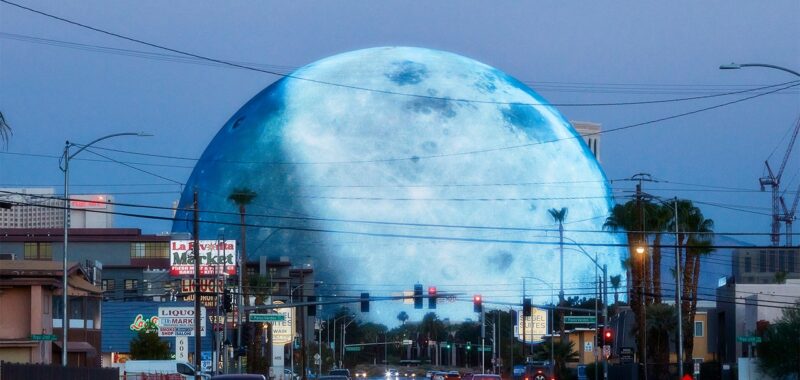On hot, cloudy nights, the artist and writer Brent Holmes will sometimes stand in the backyard of his house, near Las Vegas’s Chinatown, and look to the east. Behind a screen of clouds, he’ll see flashes of light and the desert -dweller in him will feel instinctive relief: A thunderstorm is on its way, something to cool off the intense, lingering heat of the day. Holmes will take a deep inhale but then frown. No smell of an impending storm. And then it will hit him:
“Oh. No. It’s the fucking Sphere.”
We were standing in the parking lot of a strip mall in Chinatown, contemplating a third dinner of dim sum, after previously eating at a Japanese izakaya and a nearby fusion restaurant. It was 10 p.m. and 102 degrees. The day had already taken us from the Rat Pack casinos and urbanist experiments of Downtown, through the traditionally Black neighborhood of the Historic Westside, to taco trucks and catfish-plate lunches, through the galleries and hidden museums of Las Vegas’s art scene and beyond. But inevitably, we came around to the one thing you need to talk about if you want to talk about Las Vegas as we approach the quarter mark of the 21st century.
You spot Sphere (not, sadly, The Sphere, just Sphere) out of the window on approach to Harry Reid International Airport. You glimpse Sphere between the glimmering towers of casinos as you navigate the Strip. Sometimes, you turn a corner and Sphere is actually looking at you. With eyes. At night, on the other side of your blackout curtains, you can feel it pulsing, flashing its loop of screen savers, concert promos, and UPS ads.
Sphere, on the off chance you haven’t met, is the $2.3 billion, 366-foot-tall, immersive venue built by Madison Square Garden Entertainment CEO James Dolan. It is a supercharged, sci-fi plaything that has hosted residencies by the likes of U2, Phish, Dead & Company, and, currently, the Eagles. (Much like Sphere, they are officially just Eagles, but there’s only so far a man can go.) What exactly happens when the place runs out of tenants with such broad and financially liquid fan bases is the subject of widespread puzzlement in Las Vegas, but maybe it’s beside the point. Sphere may more properly belong in the genre of other billionaires’ because-I-can dreams—somewhere on the moral scale between building submarines for obscenely rich passengers and everything else you could accomplish with $2.3 billion.
But, for the moment, let’s just consider the simple fact of the place. What was the last physical object built in America that everybody, grudging or not, desperately needed to see? The closest I can remember is the ripple of Golem-like attention that ran through the room the first time somebody pulled out the original iPod, the palpable hunger everybody suddenly had to lay hands on the thing. You could say it’s a little depressing that the biggest, most ambitious, most universally acclaimed project America is capable of in 2024 is a giant screen. Or, you could consider the paradoxical possibility that an enormous virtual reality machine may be the final Hail Mary for the importance of actually going somewhere. In our virtual world, what was the last cross-cultural phenomenon that—10,000 Dead & Company Reels notwithstanding—you had to travel to an actual place to experience?

